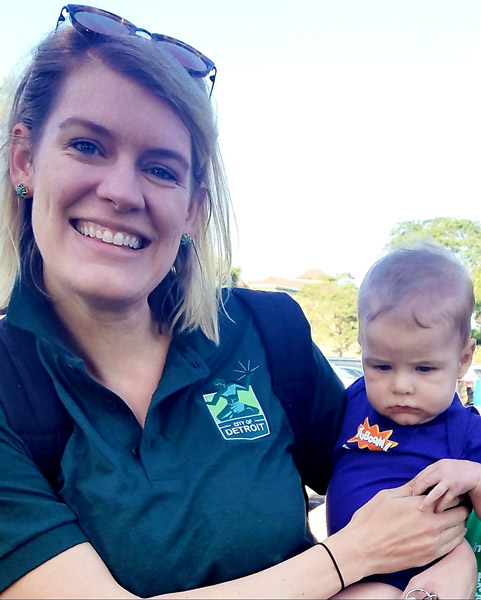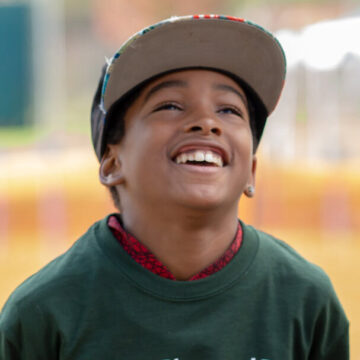A Q&A with Meagan Elliott, Chief Parks Planner for the City of Detroit

Parks and Recreation departments in cities across America are facing new challenges in the era of COVID-19. To better understand how cities are adapting to the immediate crisis while planning for an uncertain future, I sat down virtually with Meagan Elliott, Chief Parks Planner for the City of Detroit to ask her some questions that are top of mind for city leaders across the country.
How are you thinking about the role of parks and recreation during this phase of the COVID-19 crisis?
As the school year ends and summer begins, kids and families are really eager to enjoy parks, recreation centers, sports, public events, and other activities. And this is precisely why the decision to close our 11 recreation centers and cancel summer programming, classes, and events was such a painful one.
In basic terms, the world has shifted and our priorities have to shift too. Meeting basic needs like food, water, and shelter is a public health necessity, but we’re keenly aware that it’s also a racial equity issue. A recent CDC report found that while only 14% of Michigan residents are Black, they accounted for 40% of COVID-19 deaths in the month of March. Similar disparities exist in the rate of infections and hospitalizations.
As with racial gaps in a range of other outcomes, structural inequalities in access to housing, education, jobs, healthcare, and other resources are to blame. I was struck by a recent piece published by the Brookings Institution that rightly pointed out how Black Americans have, in effect, been marginalized through the centuries-long “social distancing” policies of segregation, discrimination, and devaluation.
How does all of this effect kids?
The effects of COVID-19 on kids is dramatic—disrupted learning, isolation from friends and loved ones, uncertainty around basic needs, and being cut off from the things that make summer feel like summer.
The question we are faced with is twofold: How can city agencies direct resources to help address the inequitable impact of COVID-19 while also working to expand access to play and recreation using a racial equity lens over the long-term?
So let’s start in the immediate term. What does it look like in practice to shift those priorities?
In thinking about the programming that we do in our recreation centers, the partnerships that we establish, and how we manage public spaces, we have shifted to a prioritization of need rather than offering a wide-ranging list of program offerings. We want to focus on core services that we do well and the ways that those core services can help to stabilize individual households in need as well as whole neighborhoods.
One of our most immediate shifts came when Detroit Public Schools closed its school buildings in March. More than 86% of students in the district qualify for free or reduced price lunch and 33% of Detroit households are food insecure, underscoring the importance of access to healthy food even in a non-crisis situation.
To help meet this need, our recreation centers became critical nodes in a food distribution network for kids and families in the City of Detroit almost overnight. We also implemented a meal distribution program for seniors in partnership with Detroit Area Agency on Aging. This support ensures residents have the resources necessary to shelter-in-place. Additionally, Gleaners Food Bank uses Detroit recreation centers as hubs for distribution of food boxes including two weeks of shelf stable food options.
Finally, in the midst of our rapid response to immediate needs we are beginning to think about how we can create opportunities for kids and families to play safely given the current and expected future public health guidelines. We have convened a group of critical summer and out of school time service providers, and have begun to develop a process for how those program providers can have their programs and protocols individually and collectively vetted by medical professionals. We want a clear system and process in place that everyone can use as a resource.
We are also working to address mental health needs for those dealing with grief, anxiety, and trauma — an area we recognized as necessary prior to COVID-19 but is even more critical now. In conjunction with that medical vetting of summer programming strategies, we are developing mental health partnerships to more proactively integrate mental wellbeing into the “new” versions of all citywide programs.
Between now and when our playgrounds fully open, we’re looking at fun, child friendly play installations similar to the KABOOM! Play Everywhere projects that can be incorporated into paths and walkways throughout the park system and adjacent neighborhoods.
As we look beyond the immediate crisis of COVID-19, how are you thinking about meeting the needs of kids and other Detroit residents—specifically with an equity lens?
When developing our capital investment strategy, we mapped out the geography of investment to ensure that dollars are equitably distributed across the city. We then tested that map against a racial dot density map, as well as a map of socioeconomic status, to ensure implicit bias will not impact decision making when looking at where to make capital investments.
Mobility is another barrier to accessing parks and recreation. Many Detroiters lack transportation access—we’re a city largely built for the car where 60,000 households, 80% of whom are Black, don’t have one. Ensuring that residents only have to walk 10 minutes to get to a neighborhood park is at the forefront of our investment strategy every year to close the walking distance gap as much as possible.
Creating a range of play and recreation options beyond the traditional playground and park is an additional strategy. The Joe Louis Greenway, a 32-mile biking and walking trail that will connect the Detroit Riverfront to several neighborhoods and commercial corridors, is probably the most notable example.
The plan guiding the project incorporates racial justice as a central theme, and the project will include programming and signage that lifts up the history of Black residents, efforts to build and retain affordable housing within a ½-mile buffer of the greenway, supportive programming for nearby women and minority-owned businesses, and prioritization of construction in neighborhoods that have experienced disinvestment.
Are there past successes you can point to that you feel show promise for the future of play in Detroit?
As the City’s budget is tightened and redirected in light of COVID-19, we are again looking to the creative strategies already at the backbone of our public space work. We look forward to a continued and growing partnership with KABOOM! and local philanthropic partners that help us advance playspace equity. A prime example is the building of two beautiful playgrounds in Palmer Park and Stein Park, made possible through partnerships with KABOOM!, Ralph C. Wilson, Jr. Foundation, General Motors, Skillman Foundation, and Quicken Loans. We’ll need more public private partnerships like this post-pandemic when our city’s resources will be strapped but we will be ready to rebuild.
Looking beyond the immediate crisis, our mission of providing recreation and leisure activities for all who live, work and play in Metro Detroit will be as important as ever. We’re committed to expanding access to spaces for play and will carry forward a vision for a Detroit where play is within reach for every kid and family, regardless of race or family income.
